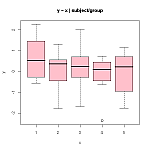
The National Sales meeting is approaching
The National Sales meeting is approaching. Each regional sales manager has to do a short presentation for the Marketing department that highlights how the consumers in their territory are different from those in the Total US. You're still working with the local regional sales manager.
- Download the Sample Data. This file contains reports generated from AMA's (American Marketing Association) website. AMA's website provides free demographical services where one can choose from a variety of criteria and generate reports based on the U.S. Census data. This particular file contains 4 reports: Census Overview, Census Employment, Census Trend, Census Population Detail based on the entire U.S.
- Download the Sample Data. This particular file contains 4 reports: Census Overview, Census Employment, Census Trend, Census Population Detail based on the U.S. zip code 60614.
- Using all 4 demographic reports (Overview, Trend, Employment and Population Detail) for Total US and zip code 60614, prepare a 1 page memo explaining how your territory differs from the national profile. Feel free to note anything that you found surprising in this data.
Prepare a 5-6 slide presentation of your major findings. You may group a category of data from the Total US and zip code 60614 and create a graph to show how they differ. The presentation should have at least one graph and a headline that summarizes a key takeaway from the graph. The last page should contain at least 3 questions that you would want answered based on what you've seen in this comparison
Solution: Looking at the provided demographics, it looks clear that the regional data differs from the total US. Most of the figures confirm that the zip code 60614 is a much wealthier area, in terms of income cost of housing and several other parameters.
Using charts we are going to highlight the main points of difference between this particular regional data, and the overall national data.

As expected, there is not a significant gender difference between the regions. We say “as expected” because gender tends to be a very homogeneous variable across populations.

The chart for the Housing Cost is rescaled for a better display. Clearly, there is a significant difference in every one of the parameters. The most radical difference is in the Median Home Value ($98,697 versus $358,471) which indicates that region 2 has certainly more expensive housing.

The graph shows that race doesn’t differ significantly, same as ethnicity (the percentage of Hispanic is essentially the same).

The Educational attainment shows a dramatic difference. Region 2 (zip code 60614) exhibits a way higher rate of achievement of Bachelor’s Degrees and Graduate and professional degrees than the whole country. This difference is very significant.

Again there are significant differences. The household is much more crowded in the whole than in region 2. Considering that the housing cost is lower in the whole country, which maybe indicates smaller houses, this suggests that the standard of living in region 2 is much higher than in the whole country.

As expected, the Income summary reveals a difference between the regions. Even though the Average HH income is much higher in region 2 ($67,550 versus $38,453), the median HH income is not that different ($43,459 versus $32,188). This suggests that there must be a class of rich people in region 2 who push the average higher but that doesn’t translate in a higher median (In terms of measuring income, it’s an accepted fact that the median is better indicator than the average, because it also considers distribution of wealth to some extent).

The previous graph shows that zip code 60614 is a much newer region.

The figures for employment show a higher rate of people not in the labor force in the whole country, but they show a similar unemployment rate.

The last chart shows an interesting fact: people from the wealthier area (zip code 60614) have a longer commute than the overall country. Maybe they got better jobs that demanded a longer commute.

The school enrollment figures show that people from region 2 tend to go less to public elementary/high schools.
After reviewing the data, we can pose the following questions:
- Zip Code 60614 seems obviously a wealthier region than the overall country. Is this region an exception, or there is lots of examples of places presenting higher standards of wealth and comfort
- In the same vein of the previous question, is the United States a country with a severe problem of social inequalities?
- Seeing that the people form the wealthier area tend to go to better schools and colleges, and people have parents with more education, and they live in better and more comfortable atmospheres, can we expect the inequality problem to become more severe?
- In terms of the sales, we could ask if the wealthier region is a better market that the overall country.
Related Content


Collection of Solved Statistics Problems - StatisticsHelp

Statistics Help: Where To Find it? - StatisticsHelp

